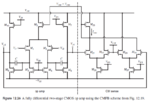Shady Ahmed
Member level 5
Hi,
I am designing a 3rd order, 1.5 bit (= 3 Level) quantizer Continuous Time Sigma Delta ADC, with maximum input frequency 1 MHz, OSR = 32.
The target SQNR = 75 dB.
The system achieves the desired SQNR using CMOS comparator, ideal op-amp & Ideal DAC.
when i tried to design the CMOS op-amp, i achieved the following specs:
GBW: 200MHz
Open Loop DC Gain= 40 dB
Phase Margin= 43 degree.
However, when i simulated the system with that op-amp , the performance is HUGELY affected, the achieved SNR = 32 dB !!!!!
What did i do wrong? are there any specs that i forgot about and should take care of in the op-amp)?
I am designing a 3rd order, 1.5 bit (= 3 Level) quantizer Continuous Time Sigma Delta ADC, with maximum input frequency 1 MHz, OSR = 32.
The target SQNR = 75 dB.
The system achieves the desired SQNR using CMOS comparator, ideal op-amp & Ideal DAC.
when i tried to design the CMOS op-amp, i achieved the following specs:
GBW: 200MHz
Open Loop DC Gain= 40 dB
Phase Margin= 43 degree.
However, when i simulated the system with that op-amp , the performance is HUGELY affected, the achieved SNR = 32 dB !!!!!
What did i do wrong? are there any specs that i forgot about and should take care of in the op-amp)?
















